《老虎》的功能文体学分析
- 格式:pdf
- 大小:335.77 KB
- 文档页数:4
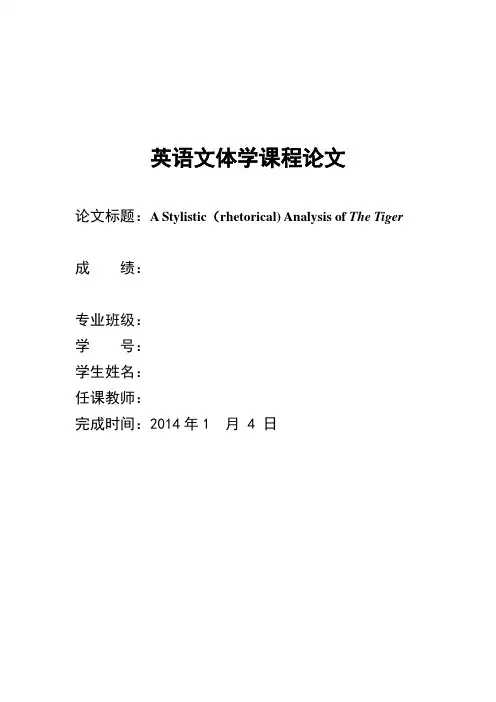
英语文体学课程论文论文标题:A Stylistic(rhetorical) Analysis of The Tiger 成绩:专业班级:学号:学生姓名:任课教师:完成时间:2014年1 月 4 日William Blake (1757-1827) Tiger!Tiger!Burning bright 老虎!老虎!光焰闪耀,In the forests of the night,在黑夜的丛林中熊熊燃烧,What immortal hand or eye 什么样的不朽之手和眼Could frame thy fearful symmetry?造成你那可怕的匀称外貌?In what distant deeps or skies 你眼中的烈火熊熊Burnt the fire of thine eyes?来自多远的深处或高空?On what wings dare he aspire?他凭什么翅膀敢飞到九天?What the hand dare seize the fire?什么样的手敢去抓这火焰?And what shoulder, and what art,什么样的臂力,什么样的技艺Could twist the sinews of thy heart?才能拧成你那心脏的腱肌?And when thy heart began to beat,什么样的手,什么样的脚,What dread hand?And what dread feet?才使得你的心脏开始弹跳?What the hammer?What the chain? 用什么样的锤子?什么样的链条?In what furnace was thy brain?在什么样的炉里炼成了你的大脑?What the anvil? What dread grasp 在什么样的铁砧上?用什么样的臂力 Dare its deadly terrors clasp?敢抓住这可以致命的可怕东西?When the stars threw down their spears,当星星投下他们的矛枪,And watered heaven with their tears,用他们的泪水浇灌穹苍,Did he smile his work to see?他见到自己的作品时可微笑?Did he who made the Lamb make thee?难道是他造了你也造了羊羔?Tiger!Tiger!Burning bright 老虎!老虎!光焰闪耀,In the forests of the night,在黑夜的丛林中熊熊燃烧,What immortal hand or eye,什么样的不朽之手和眼Dare frame thy fearful symmetry?造成你那可怕的匀称外貌?ContentsAbstract in English (Ⅰ)Chapter ⅠIntroduction (1)1.1 Brief Introduction of the Author—William blake (1)1.2 The Writing Background of The Tiger (2)Chapter ⅡThe Stylistic Feature of the poem’s R hythm2.1Meter (3)2.2 Rhyme (4)2.3 Anaphora (5)Chapter Ⅲ The Stylistic Feature of the Poem’s Rhetoric3.1 Symbolism (6)3.2 Allusion (8)Chapter Ⅳ4.1 Conclusion (9)Reference (10)Abstract in EnglishThe Tiger, William Blake’s poem, was published in a collection of poems: Songs of Experience in 1794. Literary critic Alfred Kazin calls it "the most famous of his poems," and The Cambridge Companion to William Blake says it is "the most anthologized poem in English." It is one of Blake's most reinterpreted and arranged works. In the thesis, I will attempt to make a stylistic analysis of this poem; the analyses will focus on the poem’s r hythm and rhetoric. The aim is to let readers understand the distinctive features and inner meaning of this poem, at the same time, understand the poet’s emotion on this poem.Key Words: William Blake The Tiger stylisticChapter ⅠIntroduction1.1 Brief Introduction of the Author—William BlakeWilliam Blake is a transitional figure that marks the end of the 18th century and the beginning of the 19th century in literature. He tries to show the romantic ideas but the form he used is conventional, close to the 18th century. And of all the romantic poets of the eighteenth century, William Blake is the most independent and the most original poet. Blake's early work was written in a classical style. Later he used the romantic style made popular by Wordsworth and Coleridge.Blake was born in London and educated at Henry Pars Drawing School. After becoming established as a graphic designer and drawing tutor, he opened a print shop in London in 1784. He lived in Sussex from 1800 to 1803, during which time he was charged with high treason but acquitted. He returned to London and staged a rather unsuccessful show of his artistic work in 1809, after which he went into obscurity and became a mystic.As a supporter of the French Revolution, he openly criticized the social evils that he linked with the Industrial Revolution. His work is usually seen in the context of his social, political and religious beliefs. He was not really understood by his peers, but twentieth-century readers appreciate the greatness he achieved in his varied fields of interest.1.2 The Writing Background of The TigerThe Songs of Experience was published in 1794. At that time, the French Revolution and the American War of Independence broken out. For Black, an underprivileged craftsman lived in London. Which had been internalized into great spiritual event, not just in generally favor, but warmly support. And it inspired him to battle bravely in his heart for the new world as a prophecy of his imminent. The Tiger is written in such a background and expresses a strong desire for revolutionary feelings. Blake puts violent revolution as a great spiritual power that can destroy an old world which represses and imprisons people, and the world can transform the human soul in order to establish an earthly kingdom .Chapter ⅡThe Stylistic Feature of the poem’s Rhythm2.1MeterMeter is the basic structure with a foot in western poetry verse rhythm. There are four commons: iambic, trochaic, and anapestic iambic and dactylic.A line of poetry can be divided into several groups’ feet. A group foot usually obeys the following forms: iamb/iambic, trochee/trochaic, dactyl/dactylic, anapest/anapestic, spondee/pyrrhic. And they can be mixed with the use. When need to divide the English poetry foot, we usually mark with a tone to express its strong or weak.In this poem, William Blake adopts the trochaic tetrameter in the whole poem so as to imitate the sound in a forge and set the dignified and stately tone for the whole poem:/ ˇ /ˇ / ˇ /Tiger! |Tiger! | Burning| BrightBy deliberately making the stress sounds fall into the more important words, Blake expresses the power and strength of the tiger, and adds to the musical beauty when reading it.The Tiger, beginning with plosive, abrupt, rapid in the first sentence, is trochaic tetrameter step. This is the basic metrical rhythm of the poem. Such a heavy tone (╱) and a light tone (∨) are in line with the rhythm produced by the hammer blacksmith waves and beats struggle on the anvil. So, it is formed an anvil music. This rhythm, swirling in the poem,fits the scenes of casting tiger and perfectly loads “forging tiger” in this content. The poem at the end of step 7 syllables four syllables trochaic line eliminates the need for a light syllable, which adds to the intensity of the sound fourth step. That makes the readers cannot stop and hurrily turn downward and feel the cast who cannot wait begins a new round of percussion. The poem tiger is in syllables step trochaic tone and intersperses among some of declension. For example the first 4、10、11、18、20、24 lines, each line has eight syllables and basically can be divided into four syllables iambic tetrameter. The sixth verse repeats the first verse on the contents excepting on word (dare VS could). But it expresses the sublimation on the poet’s admiration for The Tiger. On the rhythm, the sixth stanza and the first stanza verse are completely identical: loop back and forth, resonance, end to end convergence, and that forms a non-porous integral, the theme of The Tiger imagery performs indestructible and cathartic thoroughly.2.2 RhymeRhyme is an important element of musical beauty of poetry and is an important means to make rhyming words so rich in musical association. Alliteration and assonance can trip string of words in poetry; end rhyme can be connected to the line into articles. Rhyme can make poem become an organic whole by resonant voice resonates. Alliteration is made by plosive; end rhyme and assonance are consisted by loud vowel anddiphthongs in The Tiger. This makes the poem harmony compact, context similarities. Plosive in this poem looks like percussion under the hammer. Loud vowel is like an explosive cry when the blacksmith is struggling to build. This extraordi nary force creates that tiger has “fearful symmetry”, “the fire of thy eyes”, “the sinews of thy heart”,“In what furnace was thy brain?” where this is by no means made the flesh body, and its divinity makes us awesome.The alliteration of the poem, The Tiger,plays an important role in sound and the theme. For example, the first verse “Tiger!Tiger!Burning bright”, the fifth verse “distant deeps” and the eleventh verse “began to beat”help create a sing-song rhythm, among which many stops such as /b/ /d/ /t/ /p/ are used to imitate the sound of the hammer, thus which paint a vivid image in front of the reader of the making the tiger, also give them a hint of the destructive force of the beast. Every two verses have the same end rhyme (bright/night, eye/symmetry, skies/eyes) and most of the rhymes are masculine rhymes “bright/ night, art/ heart, see/ thee”, which strengthen the image of the tiger with an overwhelming momentum.2.3 AnaphoraAnaphora is the oldest and the most practical means of writing poems. In terms of its classification whatever is from what kind of angle, the function and role of the repetition is the same: rendering the feelings, heighten the atmosphere; form the melodious rhythm; strengthen therepeated parts meaning; modificate the verse. Anaphora is used for the subject discussed “tiger! Tiger!” and also the first stanza and the last one are identical so that readers can feel the power of the beast from the very beginning. On the one hand, the anaphora expresses the poet’s emotion and resonate readers feelings, on the other hand, it can highlighten the theme---support the French Revolution, praise the violent revolutionary forces.Chapter ⅢThe Stylistic Feature of the Poem’s Rhetoric 3.1 SymbolismSymbolism, borrowing a specific image of the things to implie a specific person or affair, is based on a link between things to show some kind of abstract concepts, ideas and emotions. The performance results of the symbolic are: have pregnant meaning; enrich people’s association; make people thought-provoking; give people a concise, real sense of the image; express sincere feelings.The meaning of symbolism in The Ttiger is open. Firstly, tiger has a religious symbolism with mysterious. In first-second stanza, the poet praises the magic and the courage to take wings to catch fire of the creator. “On what wings dare he aspire ?” means courage and expresses the broad mindness of the tiger’s founder.In first stanza “What immortal hand or eye Could frame thy fearful symmetry?” poet makes a strong question. “Fearful” and “symmetry” express the image---tiger powerfuland the poet’s praise on molder. Secondly, tiger has a significance symbolism of the revolution. From the view of historical background, Blake’s era is the era that British society changes dramatically. Society change that is of great historical significance has been ensuing. British Industrial Revolution, the American Revolution, the French Revolution. This is an era which revolutionary and counterrevolutionary forces fight fiercely. So his poetry is the product of this troubled era. At the beginning of the poem, “Tiger!Tiger!Burning bright”, we can feel the tremendous power of the fire of the revolution. In poetry, “the tiger” symbolizes revolution; “fearful symmetry” is a symbol of the great revolution; “the fire of thine eyes” stands for the fire of revolution. “thy heart” symbolizes the core of the revolution; “dread hand ”and “dread feet” is a symbol of the power of the revolution; “thy brain” symbolizes the guiding ideology of the revolution. “Did he smile his work to see?Did he who made the Lamb make thee?” expresses where there is oppression, where there is the emergence of resistance. And the tiger is symbolic of the revolutionary forces---the French people in the French Revolution. Blake is a supporter and he believes it could destroy the old system and establish a new one. In a word, Blake wants to show anti-traditional and anti-rationalism by this passion of the revolution and the spirit of the rebellion.Some words in this poem also bore other symbolic meanings. Forexample, “the fire imagery” symbolize trials (baptism by fire perhaps); “the forest of the night” represents unknown realms or challenges; “the blacksmith” represents the Creator; “the fearful symmetry” symbolizes the existence of both good and evil, the knowledge that there is opposition in all things, a rather fearful symmetry indeed. “The lamb” represents innocence, youth, and pleasant aspect of nature.3.2 AllusionAllusion is an indirect reference to people or things outside the text in which it occurs, without mentioning them explicitly. Allusions require common reading and cultural experiences shared by the writer and the reader. Allusion is the figure of speech based on resemblance which is as a reference of work of literature to another work of literature or to a well-known person, place or event outside of literature.The allusion in The Tiger is mainly derived from Greek mythology, the Bible, literary classics and historical events. For example, In first-second stanza, the poet praises the magic and the courage to take wings to catch fire of the creator. “On what wings dare he aspire ?”(line 7) means courage. That uses the story about Daedalus and his son Icarus of the Greek myth. Poet borrows this story to express the broad mindness of the tiger’s founder.“Seize the fire” (line 8) is borrowed from the Greek mythology that Prometheus takes the fire in order to benefit mankind. This expresses the courage of the creator. “ And water’d heaven withtheir tears”(line 17) is an allusion to Satan and his angels and also to the God of Old Testament. It could be debated that Blake argues here that the Fallen Archangel Lucifer is the creator of the tiger, or the beastly part of our own nature. The abundant use of allusion adds to the ambiguity of the poem, thus leads to many versions of interpretation of this poem. Chapter Ⅳ4.1 ConclusionThe Tiger was written in the French Revolution. As a supporter of the French Revolution, William Blake takes the image of “the tiger” to represent an unstoppable force by his pure goodness of nature and the politics tendency of supporting the revolution. In this poem, William Blake uses a simple structure and several Stylistic Features to help the reader see the images he wants to transmit: humans are incapable of full understanding the mind of God and the mystery of his handiwork. Literally, Blake is praising the skill and courage of the maker of the tiger. Symbolically, Blake is praising the French Revolution and the violent revolutionary forces. At the same time, William Blake successfully puts his democratic ideas into the image and symbolism.(Total number:2215)Reference:【1】康利英. 2012.从文体学角度分析威廉·布莱克诗歌《老虎》隐喻意义的体现——以威廉·布莱克的《老虎》为例[J]. 忻州师范学院学报,(6):68 - 70.【2】王博.2010.威廉·布莱克诗歌的文体分析[D].辽宁:辽宁大学. 【3】李延福.国外语言学通观[M].济南: 山东教育出版社, 1999:818.【4】胡曙中.英汉修辞比较研究[M].上海:上海外语教育出版社, 1993:373.。
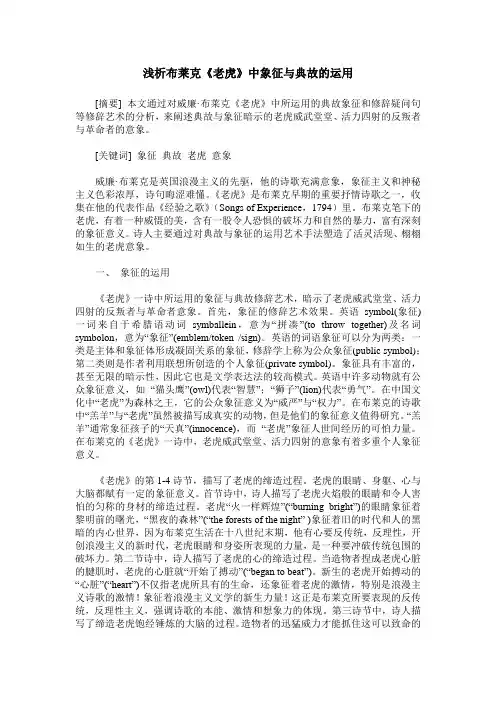
浅析布莱克《老虎》中象征与典故的运用[摘要] 本文通过对威廉·布莱克《老虎》中所运用的典故象征和修辞疑问句等修辞艺术的分析,来阐述典故与象征暗示的老虎威武堂堂、活力四射的反叛者与革命者的意象。
[关键词] 象征典故老虎意象威廉·布莱克是英国浪漫主义的先驱,他的诗歌充满意象,象征主义和神秘主义色彩浓厚,诗句晦涩难懂。
《老虎》是布莱克早期的重要抒情诗歌之一,收集在他的代表作品《经验之歌》(Songs of Experience,1794)里。
布莱克笔下的老虎,有着一种威慑的美,含有一股令人恐惧的破坏力和自然的暴力,富有深刻的象征意义。
诗人主要通过对典故与象征的运用艺术手法塑造了活灵活现、栩栩如生的老虎意象。
一、象征的运用《老虎》一诗中所运用的象征与典故修辞艺术,暗示了老虎威武堂堂、活力四射的反叛者与革命者意象。
首先,象征的修辞艺术效果。
英语symbol(象征)一词来自于希腊语动词symballein,意为“拼凑”(to throw together)及名词symbolon,意为“象征”(emblem/token /sign)。
英语的词语象征可以分为两类:一类是主体和象征体形成凝固关系的象征,修辞学上称为公众象征(public symbol);第二类则是作者利用联想所创造的个人象征(private symbol)。
象征具有丰富的,甚至无限的暗示性,因此它也是文学表达法的较高模式。
英语中许多动物就有公众象征意义,如“猫头鹰”(owl)代表“智慧”;“狮子”(lion)代表“勇气”。
在中国文化中“老虎”为森林之王,它的公众象征意义为“威严”与“权力”。
在布莱克的诗歌中“羔羊”与“老虎”虽然被描写成真实的动物,但是他们的象征意义值得研究。
“羔羊”通常象征孩子的“天真”(innocence),而“老虎”象征人世间经历的可怕力量。
在布莱克的《老虎》一诗中,老虎威武堂堂、活力四射的意象有着多重个人象征意义。
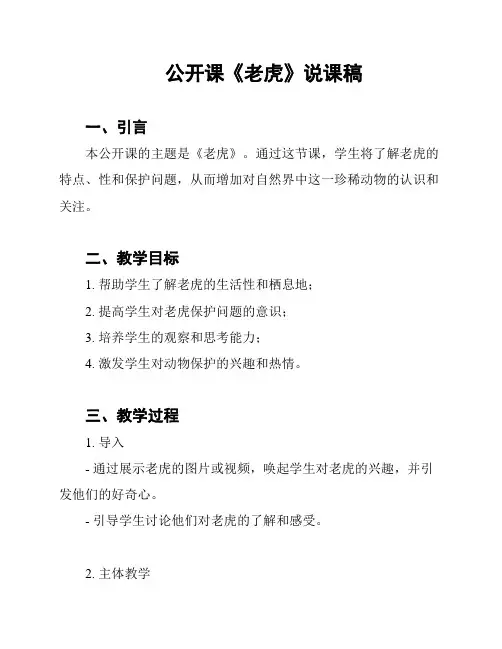
公开课《老虎》说课稿一、引言本公开课的主题是《老虎》。
通过这节课,学生将了解老虎的特点、性和保护问题,从而增加对自然界中这一珍稀动物的认识和关注。
二、教学目标1. 帮助学生了解老虎的生活性和栖息地;2. 提高学生对老虎保护问题的意识;3. 培养学生的观察和思考能力;4. 激发学生对动物保护的兴趣和热情。
三、教学过程1. 导入- 通过展示老虎的图片或视频,唤起学生对老虎的兴趣,并引发他们的好奇心。
- 引导学生讨论他们对老虎的了解和感受。
2. 主体教学- 介绍老虎的特点和栖息地:身材、颜色、食物来源等。
- 分享一些关于老虎的有趣事实和生活性。
- 引导学生思考老虎为什么濒临灭绝,并讨论保护老虎的重要性。
3. 活动设计- 分组讨论:让学生分成小组,讨论并展示如何保护老虎,例如宣传活动、法律保护、野生动物保护园等。
- 观察练:给学生分发老虎的图片或观察记录表,让他们观察并记录老虎的特点和行为。
4. 总结- 对学生进行回顾和总结,强调保护老虎的重要性,鼓励他们关注动物保护事业。
四、教学评估1. 通过学生的活动展示和观察记录表,评估学生对老虎特点和性的理解程度。
2. 视学生分组讨论的表现,评估他们对老虎保护问题的思考和参与能力。
五、延伸活动1. 邀请动物保护工作者或专家进行讲座,加深学生对动物保护的认识。
2. 组织学生参观野生动物保护园等相关活动,增加实践与体验。
在本节公开课中,我们将通过多种教学方法,让学生全面了解老虎,并培养他们的保护意识和动物关爱精神。
希望学生能通过这节课的学习,反思自己与动物的关系,懂得尊重和保护自然界中的珍稀动物。
谢谢!。
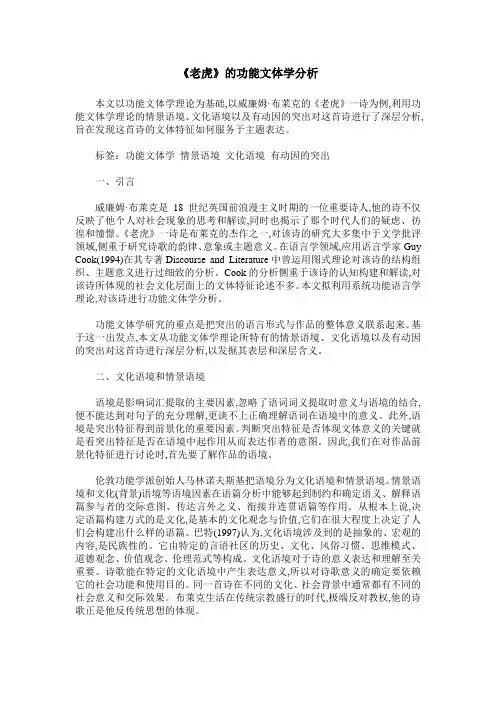
《老虎》的功能文体学分析本文以功能文体学理论为基础,以威廉姆·布莱克的《老虎》一诗为例,利用功能文体学理论的情景语境、文化语境以及有动因的突出对这首诗进行了深层分析,旨在发现这首诗的文体特征如何服务于主题表达。
标签:功能文体学情景语境文化语境有动因的突出一、引言威廉姆·布莱克是18世纪英国前浪漫主义时期的一位重要诗人,他的诗不仅反映了他个人对社会现象的思考和解读,同时也揭示了那个时代人们的疑虑、彷徨和憧憬。
《老虎》一诗是布莱克的杰作之一,对该诗的研究大多集中于文学批评领域,侧重于研究诗歌的韵律、意象或主题意义。
在语言学领域,应用语言学家Guy Cook(1994)在其专著Discourse and Literature中曾运用图式理论对该诗的结构组织、主题意义进行过细致的分析。
Cook的分析侧重于该诗的认知构建和解读,对该诗所体现的社会文化层面上的文体特征论述不多。
本文拟利用系统功能语言学理论,对该诗进行功能文体学分析。
功能文体学研究的重点是把突出的语言形式与作品的整体意义联系起来。
基于这一出发点,本文从功能文体学理论所特有的情景语境、文化语境以及有动因的突出对这首诗进行深层分析,以发掘其表层和深层含义。
二、文化语境和情景语境语境是影响词汇提取的主要因素,忽略了语词词义提取时意义与语境的结合,便不能达到对句子的充分理解,更谈不上正确理解语词在语境中的意义。
此外,语境是突出特征得到前景化的重要因素。
判断突出特征是否体现文体意义的关键就是看突出特征是否在语境中起作用从而表达作者的意图。
因此,我们在对作品前景化特征进行讨论时,首先要了解作品的语境。
伦敦功能学派创始人马林诺夫斯基把语境分为文化语境和情景语境。
情景语境和文化(背景)语境等语境因素在语篇分析中能够起到制约和确定语义、解释语篇参与者的交际意图、传达言外之义、衔接并连贯语篇等作用。
从根本上说,决定语篇构建方式的是文化,是基本的文化观念与价值,它们在很大程度上决定了人们会构建出什么样的语篇。
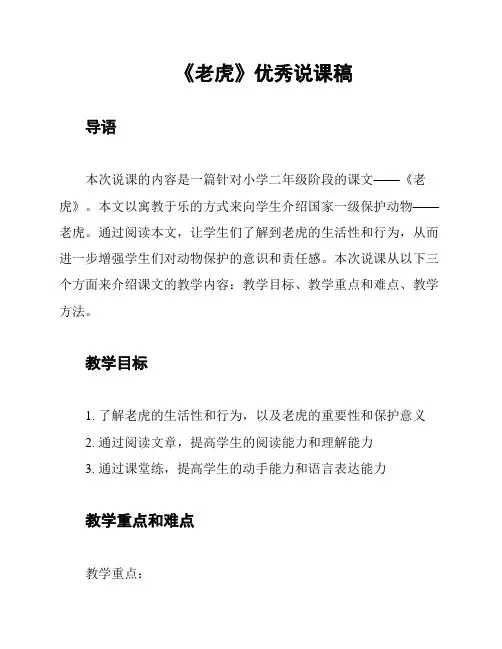
《老虎》优秀说课稿
导语
本次说课的内容是一篇针对小学二年级阶段的课文——《老虎》。
本文以寓教于乐的方式来向学生介绍国家一级保护动物——老虎。
通过阅读本文,让学生们了解到老虎的生活性和行为,从而进一步增强学生们对动物保护的意识和责任感。
本次说课从以下三个方面来介绍课文的教学内容:教学目标、教学重点和难点、教学方法。
教学目标
1. 了解老虎的生活性和行为,以及老虎的重要性和保护意义
2. 通过阅读文章,提高学生的阅读能力和理解能力
3. 通过课堂练,提高学生的动手能力和语言表达能力
教学重点和难点
教学重点:
1. 让学生能够正确的理解文章的大意,提高学生的阅读理解能力
2. 通过问答和练,让学生更深入地了解老虎的生活性和行为惯
3. 增强学生对动物保护的意识和责任感
教学难点:
1. 学生对老虎的认知比较片面,需要从故事中进一步了解这一国宝级动物
2. 如何让学生真正吸取和体会到保护动物的重要性和意义
教学方法
本次说课将通过以下方式来完成:
1. 给学生们上一小堂自然科学相关的课程,让他们有一个基础认识
2. 让学生们先独立阅读本文,再分小组进行讨论
3. 向学生们提出几个问题,来帮助他们理解文章的内容
4. 进行语言练,增强学生对所学内容及其它生动动物的理解力
总结
通过对《老虎》这篇文章的教学,我们既给学生们带来了阅读和语言练习方面的收获,同时也让他们更加深刻地认识到保护动物的重要性和意义,进一步增强了学生们的社会责任感和环保意识。
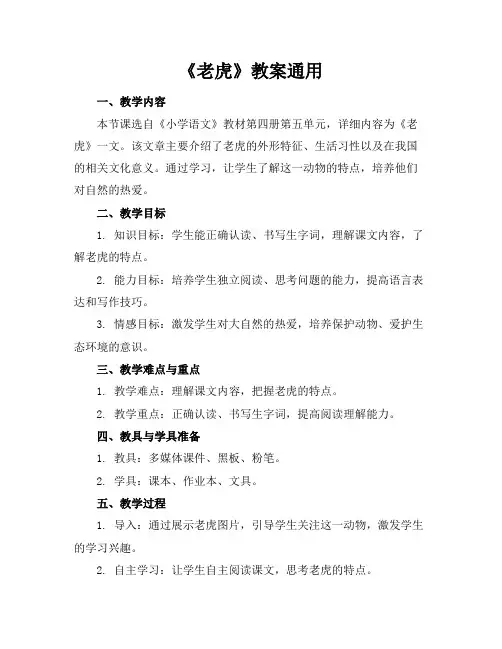
《老虎》教案通用一、教学内容本节课选自《小学语文》教材第四册第五单元,详细内容为《老虎》一文。
该文章主要介绍了老虎的外形特征、生活习性以及在我国的相关文化意义。
通过学习,让学生了解这一动物的特点,培养他们对自然的热爱。
二、教学目标1. 知识目标:学生能正确认读、书写生字词,理解课文内容,了解老虎的特点。
2. 能力目标:培养学生独立阅读、思考问题的能力,提高语言表达和写作技巧。
3. 情感目标:激发学生对大自然的热爱,培养保护动物、爱护生态环境的意识。
三、教学难点与重点1. 教学难点:理解课文内容,把握老虎的特点。
2. 教学重点:正确认读、书写生字词,提高阅读理解能力。
四、教具与学具准备1. 教具:多媒体课件、黑板、粉笔。
2. 学具:课本、作业本、文具。
五、教学过程1. 导入:通过展示老虎图片,引导学生关注这一动物,激发学生的学习兴趣。
2. 自主学习:让学生自主阅读课文,思考老虎的特点。
3. 课堂讲解:针对课文内容,讲解生字词,解析老虎的外形特征、生活习性等。
4. 实践情景引入:播放老虎相关的视频资料,让学生更加直观地了解老虎的生活。
5. 例题讲解:结合课文内容,设计练习题,指导学生进行答题。
6. 随堂练习:让学生做课后练习题,巩固所学知识。
六、板书设计1. 《老虎》2. 内容:外形特征:毛色、体型、条纹等生活习性:食物、活动范围、繁殖等文化意义:象征、传说等七、作业设计1. 作业题目:(1)写出课文中提到的老虎的特点。
(2)谈谈你对老虎的认识,以及如何保护这一动物。
2. 答案:(1)老虎的特点:体型庞大、毛色橙黄、有黑色条纹,主要生活在森林、草原等地区,以肉类为主食,具有较强的攻击性。
(2)保护老虎的方法:加强法律法规的宣传和执行,保护老虎的栖息地,禁止非法捕猎、买卖老虎制品等。
八、课后反思及拓展延伸1. 反思:关注学生的学习效果,针对学生的掌握情况,调整教学方法,提高教学质量。
2. 拓展延伸:引导学生关注其他野生动物,了解它们的生存现状,提高学生的环保意识。
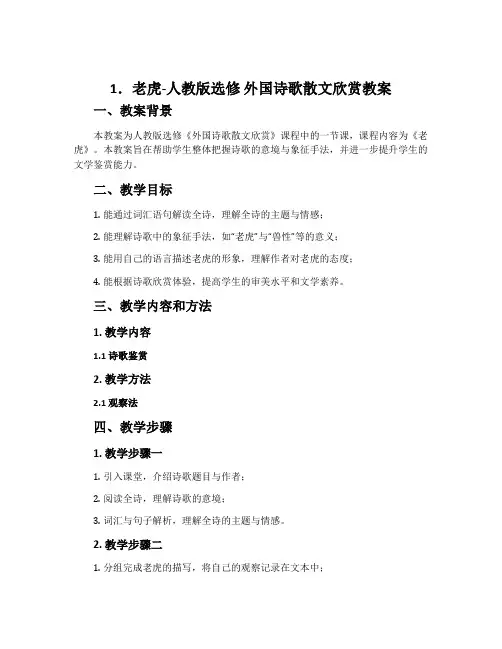
1.老虎-人教版选修外国诗歌散文欣赏教案一、教案背景本教案为人教版选修《外国诗歌散文欣赏》课程中的一节课,课程内容为《老虎》。
本教案旨在帮助学生整体把握诗歌的意境与象征手法,并进一步提升学生的文学鉴赏能力。
二、教学目标1.能通过词汇语句解读全诗,理解全诗的主题与情感;2.能理解诗歌中的象征手法,如“老虎”与“兽性”等的意义;3.能用自己的语言描述老虎的形象,理解作者对老虎的态度;4.能根据诗歌欣赏体验,提高学生的审美水平和文学素养。
三、教学内容和方法1. 教学内容1.1 诗歌鉴赏2. 教学方法2.1 观察法四、教学步骤1. 教学步骤一1.引入课堂,介绍诗歌题目与作者;2.阅读全诗,理解诗歌的意境;3.词汇与句子解析,理解全诗的主题与情感。
2. 教学步骤二1.分组完成老虎的描写,将自己的观察记录在文本中;2.“老虎”的象征意义分析。
3. 教学步骤三1.向学生介绍诗歌创作背景;2.与学生一起探讨作者写作的动机和目的。
五、教学效果评估教学过程中可根据学生的情况进行实时反馈和调整,可以利用类似以下方式进行评估:1. 问答交流通过问答交流的方式,观察学生对诗歌的理解程度和技法掌握情况。
2. 文本分析对学生的观察记录进行分析,看学生对老虎的情感表达和对象征意义的认识。
六、教学反思教学效果评估,分析学生的优劣势和改进措施。
在教学过程中,要注重培养学生的文学鉴赏能力和语言表达能力。
同时,要引导学生学会发现诗歌的“内涵”,理解诗歌所要表达的思想和情感。
最后,教师可以将学生的练习文本进行分享,让学生相互学习,共同提升。
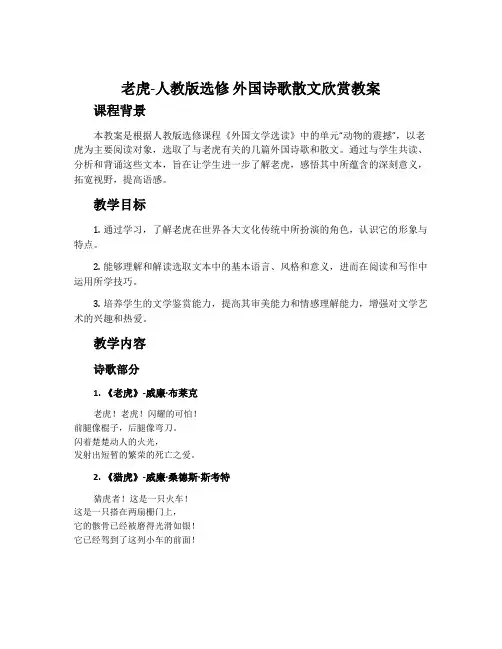
老虎-人教版选修外国诗歌散文欣赏教案课程背景本教案是根据人教版选修课程《外国文学选读》中的单元“动物的震撼”,以老虎为主要阅读对象,选取了与老虎有关的几篇外国诗歌和散文。
通过与学生共读、分析和背诵这些文本,旨在让学生进一步了解老虎,感悟其中所蕴含的深刻意义,拓宽视野,提高语感。
教学目标1.通过学习,了解老虎在世界各大文化传统中所扮演的角色,认识它的形象与特点。
2.能够理解和解读选取文本中的基本语言、风格和意义,进而在阅读和写作中运用所学技巧。
3.培养学生的文学鉴赏能力,提高其审美能力和情感理解能力,增强对文学艺术的兴趣和热爱。
教学内容诗歌部分1. 《老虎》-威廉·布莱克老虎!老虎!闪耀的可怕!前腿像棍子,后腿像弯刀。
闪着楚楚动人的火光,发射出短暂的繁荣的死亡之爱。
2. 《猎虎》-威廉·桑德斯·斯考特猎虎者!这是一只火车!这是一只搭在两扇栅门上,它的骸骨已经被磨得光滑如银!它已经驾到了这列小车的前面!散文部分3. 《为了蓝眼睁着的老虎》-伊莎贝尔·阿列克谢耶芙娜4. 《最后一只老虎》-比尔·布莱森教学方法本教案采用互动式、体验式、探究式和综合式的教学方法,让学生积极参与其中。
具体包括:1.通过语音分享方式,对诗歌进行语音朗读,并分析抒情、修辞、意象等,让学生感受作者情感和表现力。
2.学生阅读《为了蓝眼睁着的老虎》时,采取读后讨论的方式,围绕老虎保护问题展开话题讨论,引导学生理解文本意义并思考热点问题。
3.通过阅读《最后一只老虎》,采用语音录制反复朗读、小组合作、表演等方式,让学生全面了解老虎保护工作的重要性,鼓励其体验和感受文本所蕴含的生动情感。
教学评价教师将通过以下方式进行学生的评价:1.通过听读评价,考察学生的语音朗读能力和表达能力。
2.采取写作、听说评价等方法,考察学生对学习内容的理解能力和语言运用能力。
3.对学生的表现、参与活动、讲解和表演等进行综合评价。
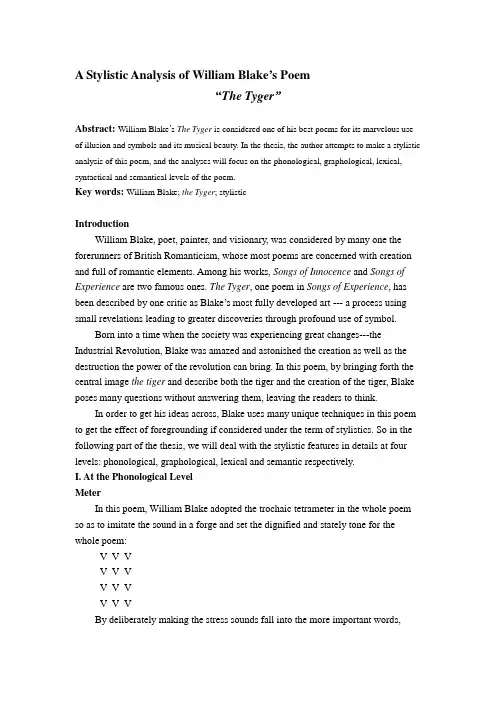
A Stylistic Analysis of William Blake’s Poem“The Tyger”Abstract: William Blake’s The Tyger is considered one of his best poems for its marvelous use of illusion and symbols and its musical beauty. In the thesis, the author attempts to make a stylistic analysis of this poem, and the analyses will focus on the phonological, graphological, lexical, syntactical and semantical levels of the poem.Key words: William Blake; the Tyger; stylisticIntroductionWilliam Blake, poet, painter, and visionary, was considered by many one the forerunners of British Romanticism, whose most poems are concerned with creation and full of romantic elements. Among his works, Songs of Innocence and Songs of Experience are two famous ones. The Tyger, one poem in Songs of Experience, has been described by one critic as Blake’s most fully developed art --- a process using small revelations leading to greater discoveries through profound use of symbol.Born into a time when the society was experiencing great changes---the Industrial Revolution, Blake was amazed and astonished the creation as well as the destruction the power of the revolution can bring. In this poem, by bringing forth the central image the tiger and describe both the tiger and the creation of the tiger, Blake poses many questions without answering them, leaving the readers to think.In order to get his ideas across, Blake uses many unique techniques in this poem to get the effect of foregrounding if considered under the term of stylistics. So in the following part of the thesis, we will deal with the stylistic features in details at four levels: phonological, graphological, lexical and semantic respectively.I. At the Phonological LevelMeterIn this poem, William Blake adopted the trochaic tetrameter in the whole poem so as to imitate the sound in a forge and set the dignified and stately tone for the whole poem:_V_V_V__V_V_V__V_V_V__V_V_V_By deliberately making the stress sounds fall into the more important words,Blake expresses the power and strength of the tiger, and adds to the musical beauty when reading it.RhymeThe rhythmical sounds in this poem is achieved by the use of regular end rhymes,which is presented by the rhyme pattern aabb ccdd eeff gghh iijj aabb, and such figures of speech as alliteration and repetition.Every two lines have the same end rhyme(bright/night, eye/symmetry,skies/eyes ) and most of the rhymes are masculine rhymes(bright/night, art/heart,see/thee), which strengthen the image of the tiger with an overwhelming momentum; repetition is used for the subject discussed(Tyger! Tyger ) and also the first stanza and the last one are identical so that readers can feel the power of the beast from the very beginning; Blake also employs alliteration abundantly(burning bright, what wings, distant deeps, began to beat, dare its deadly terror clasp, frame thy fearful symmetry ), among which many stops such as /b/ /d/ /t/ /p/ are used to imitate the sound of the hammer, thus paint a vivid image in front of the reader of the making of the tiger, also give them a hint of the destructive force of the beast.II. At the Graphological LevelFormatThe whole poem contains six stanzas and each stanze is a quatrain, adding that the first stanza and the last one are identical, so the poem has a beauty of uniformity in the term of the form. Also the repetition of the stanzas makes the theme profound. PunctuationThrough the unconventional use of punctuation, particularly the question mark, Blake in this poem uses twelve whats(what dread hand? And what dread feet? ) to pose questions to create an atmosphere of mystery, giving the image of the tiger a mysterious and religious color. The exclamations used to address the tiger(Tyger! Tyger! ) help to emphasize the urgency of the question.CapitalizationIn the whole poem, except the first word of each line and the beginning of a sentence, there is still one word capitalized(Lamb in line 20 ), which probably is the intertextuality with Blake’s another poet The Lamb. By the contrast between the tiger and the lamb, Blake emphasizes the strength and the dark power of the former, also by pointing out that both the powerful tiger and the weak lamb are created by the some God, Blake expresses the divine power of the Creator.III.At the Lexical LevelPoetic and archaic wordsMany poetic words are employed by Blake to make the poem elegant and poetic(deeps, aspire, art, symmetry), also the words some times are chosen according to the end rhyme.Archaic words can be found in the poem(tyger/tiger, dread/dreadful, thy/your,thine/yours, thee/you ).Short and powerful wordsWords to show strength and speed (frame, aspire, seize, clasp, make,twist) ,words to show the process of making the tiger (hammer, chain, furnace, anvil) and words to describe the fire (fire, bright, burn) are used not only to express the power of the tiger but also to create the scene of making the tiger so as to emphasize the even greater power of the Creator.I V. At the Semantic LevelSymbolismSome words in this poem bore symbolic meanings. The tiger (the central image in the poem) is considered by many as representing the dark shadow of the human soul. This is the beastly part of ourselves that we would prefer to keep only in our dreams at night. Night(line 2 ) in Blake's poetry often seems to suggest this sort of dream time. The forests(line 2 ) might represent the wild landscape of our imagination under the influence of this beast. The heart (line 10) represents not only the biological engine of the tiger, but perhaps its passion for living.AllusionBlake also employs allusion in this poem since it is somewhat concerned with religion. For example, on what wings dare he aspire (line 7 ) is an allusion from Milton’s Paradise Lost;seize the fire ( line 8) could be a possible reference to Prometheus; and when the stars threw down their spears, and water’d heaven with their tears( lines 17 and 18) is an allusion to Satan and his angels and also to the God of Old Testament. It could be debated that Blake argues here that the Fallen Archangel Lucifer is the creator of the tiger, or the beastly part of our own nature. The abundant use of allusion adds to the ambiguity of the poem, thus leads to many versions of interpretation of this poem.ConclusionIn this thesis, we have given a careful analysis to William Blake’s The Tyger from the stylistic perspective. First, by giving an elaborate account of the phonological characteristics of the poem, we are able to get a more comprehensive understanding of the role the sound patterns played in a poem and the stately momentum created by the use of certain phonological devices such as the use ofarchaic tetrameter, alliteration and repetition. Then, we have looked into the graphological features of this poem so that we have got a better understanding of the theme. Next,through the continuous analysis of the diction of the poem, we are able to get a clear picture of the careful and deliberate choice of the short and powerful words that described the tiger and the creating of the tiger, which helped to highlight the idea the poet wants to convey, that is, the tiger has fury and grounds to believe in its own strength and it could be understood as similar to our psychological view of the ego which is the part of us that believes in its own power, in its own vision, and the creator of this powerful creature is awesome in its own right. Finally, we have analyzed the semantic characteristics, which mainly concern with the figures of speech the poem employed, which, in this case, is symbolism and allusion particularly.After this stylistic study of William Blake’s The Tyger, we are able to have a more comprehensive understanding both this poem and the importance of stylistics in analyzing and appreciating poems.References康利英. 2012.从文体学角度分析威廉·布莱克诗歌《老虎》隐喻意义的体现——以威廉·布莱克的《老虎》为例[J]. 忻州师范学院学报,(6):68-70.李菁菁. 2012.歌唱光明与驱逐黑暗的统一——布莱克的“羔羊”意象与“老虎”意象解析[J]. 大众文艺,(21):34-37.刘云雁,吴虹. 2012.威廉·布莱克诗歌的泛神主义倾向[J]. 湖南大学学报(社会科学版),(1):111-114.唐梅秀. 2010.威廉·布莱克:文化边缘的履冰者——《老虎》与《羔羊》诗的互文性解读[J]. 长沙理工大学学报(社会科学版),(2):67-71.王博. 2010.威廉·布莱克诗歌的文体分析[D]. 辽宁:辽宁大学.汪雪盈. 2010.《老虎》的象似性解读[J]. 长江大学学报(社会科学版),(2):161-162.杨志刚. 2009.论布莱克作品中的圣经元素[D]. 石家庄:河北师范大学.曾令富. 2010.布莱克诗歌《老虎》的永恒魅力与其语言的含混[J]. 宜宾学院学报,(4):29-32.。
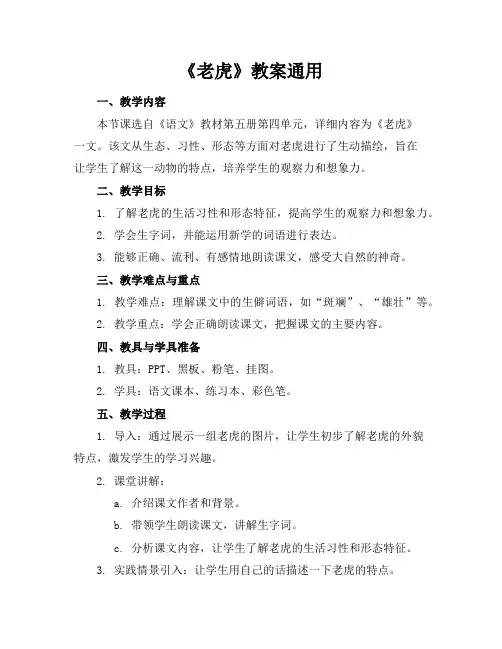
《老虎》教案通用一、教学内容本节课选自《语文》教材第五册第四单元,详细内容为《老虎》一文。
该文从生态、习性、形态等方面对老虎进行了生动描绘,旨在让学生了解这一动物的特点,培养学生的观察力和想象力。
二、教学目标1. 了解老虎的生活习性和形态特征,提高学生的观察力和想象力。
2. 学会生字词,并能运用新学的词语进行表达。
3. 能够正确、流利、有感情地朗读课文,感受大自然的神奇。
三、教学难点与重点1. 教学难点:理解课文中的生僻词语,如“斑斓”、“雄壮”等。
2. 教学重点:学会正确朗读课文,把握课文的主要内容。
四、教具与学具准备1. 教具:PPT、黑板、粉笔、挂图。
2. 学具:语文课本、练习本、彩色笔。
五、教学过程1. 导入:通过展示一组老虎的图片,让学生初步了解老虎的外貌特点,激发学生的学习兴趣。
2. 课堂讲解:a. 介绍课文作者和背景。
b. 带领学生朗读课文,讲解生字词。
c. 分析课文内容,让学生了解老虎的生活习性和形态特征。
3. 实践情景引入:让学生用自己的话描述一下老虎的特点。
4. 例题讲解:分析课文中的句子,让学生学会运用新学的词语进行表达。
5. 随堂练习:让学生模仿课文中的句子,用新学的词语造句。
六、板书设计1. 课题:《老虎》2. 主要内容:a. 老虎的生活习性b. 老虎的形态特征c. 新学的词语七、作业设计1. 作业题目:a. 抄写课文中的生字词,并解释其含义。
b. 用新学的词语造句。
c. 朗读课文,体会作者对老虎的描绘。
2. 答案:八、课后反思及拓展延伸1. 反思:本节课通过图片和课文相结合的方式,让学生对老虎有了更深入的了解。
但在课堂讲解过程中,部分学生对生僻词语的理解仍有一定难度,需要在今后的教学中加强指导。
2. 拓展延伸:鼓励学生在课后查阅关于老虎的资料,了解其生活习性和保护现状,提高学生的环保意识。
重点和难点解析1. 教学难点:理解课文中的生僻词语。
2. 教学重点:学会正确朗读课文,把握课文主要内容。
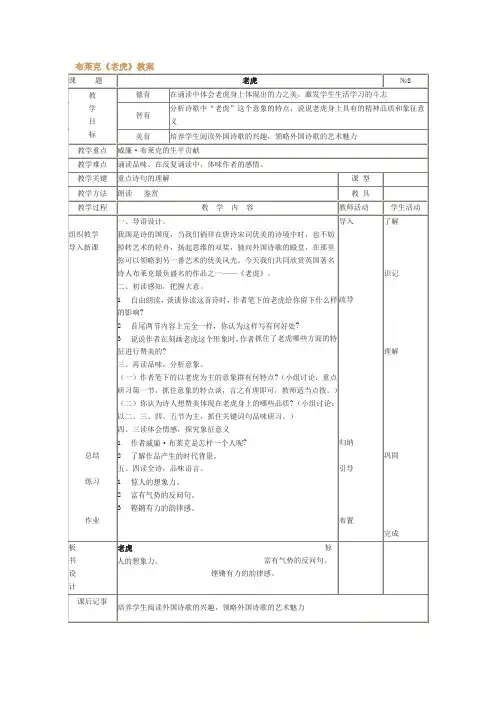
《老虎》教学设计教学设计:《老虎》一、教学目标:1.让学生通过学习和演练《老虎》一文,掌握正确的朗诵方法,培养良好的朗诵习惯。
2.提高学生的阅读理解能力,让他们能够理解、分析和解读不同类型的文章。
3.培养学生的创意思维能力和创作能力,激发他们对文学创作的兴趣。
二、教学重点:1.学习和演练《老虎》一文的正确朗诵方法。
2.分析文章的主题和情感表达。
三、教学难点:1.理解和解读《老虎》一文中的深层含义和象征意义。
2.能够准确、自如地掌握朗诵技巧。
四、教学方法:1.合作学习法:通过小组合作学习,激发学生的学习兴趣,提高学习效果。
2.解释教学法:通过教师的讲解和解读,帮助学生更好地理解文章。
3.实践探究法:通过朗诵训练和创作活动,培养学生的实际应用能力和创新能力。
五、学情分析:学生对于朗诵和文学创作可能还不太熟悉,对于如何理解和解读《老虎》一文中的深层含义可能存在一定困难。
因此,在教学过程中,应注意培养学生的观察力和思考能力,激发他们的创意思维,提高他们的文学素养。
六、教学过程:一、启发兴趣1.教师出示一张老虎的图片,向学生提问:“你们对老虎有什么了解?老虎在你们心中是什么形象?”2.学生回答后,教师根据学生的回答,介绍老虎的基本信息,激发学生对老虎的兴趣。
二、朗诵训练1.教师朗读《老虎》一文,并引导学生跟读。
2.学生分组进行朗诵训练,每个小组选出一名代表进行朗诵。
3.全班进行集体朗诵,教师加以点评和指导。
三、理解解读1.分组讨论:学生分成小组,讨论《老虎》一文中的寓意和象征意义,并找出文章中的几处重要句子。
2.小组展示:每个小组选出一名代表,进行展示和解读。
3.整合分享:教师引导全班学生进行整合分享,对于文章中的重要词句和寓意进行总结和发表观点。
四、创作活动1.分组创作:学生分成小组,每个小组以《老虎》为题材,进行创作。
2.创作成果展示:每个小组选出一名代表进行创作成果展示,学生互相欣赏和评价。
七、教学反思:通过本节课的教学,学生对于朗诵方法和文学创作有了初步的了解和体验,初步培养了学生的实际应用能力和创新能力。
布莱克《老虎》赏析指导《老虎》是诗人布莱克的一首名作,具有极强的表现力,集中体现了诗歌独特的形式魅力。
对这首诗的讲解,可以从两个方面展开:一是探究语言、形式方面的特点;二是探究“老虎”这一形象的多重内涵。
在语言、形式方面,此诗最突出的特点,首先是通过相同句式(“什么样……”)的重叠使用,形成强劲的语言节奏,一行一行诗,像锤子一下一下打在铁锭上,铿锵有力,震撼人心。
阅读此诗,即便抛开诗歌的意义,这种节奏本身,就可让读者感受到老虎威猛的气势。
其次,全诗以疑问句为主,基本上没有使用描摹、叙述的手段,但在强劲的节奏之外,也有一种视觉上的冲击力,我们仿佛真的见到一只老虎,正活灵活现地跃出纸面。
这点与布莱克同时也是个画家不无关系。
这首诗没有直接描绘老虎的形象,但诗人一连串的追问,也像画笔或刻刀一样,从多个侧面、多个角度,在读者的想像中刻画出了虎的铁掌、眼睛、体形。
这种绘画性,也表现在诗人对色彩、环境的反差的把握上,譬如,在诗的开始,“黑夜的森林和草莽”,是诗人营造的整体氛围,它黑暗、神秘又无比宽广。
正是在这一背景中,“老虎!老虎!”两个词的突然出现,才有先声夺人之效:老虎鲜艳的皮毛,“火一样辉煌”,在无边的黑夜与熊熊的火焰之间,一种充满张力的画面感,得以强烈地凸现。
从结构上说,全诗共分六节,前面四节一气呵成,可以说节奏越来越急骤,对虎的渲染也不断加强,但到了第五节“到临了,星星扔下了金枪”一句,节奏却一下子慢了下来,色彩的对比也变得柔和起来,诗人也将笔触从暗夜中的老虎,转向了缀满星斗的夜空(将星星比做“千万滴银泪”)。
如果说,前面四节诗行追问的是造物主的创造过程,那么在这一节,诗人呈现的是“创造”之后的平静:“完工了再看看,他可会笑笑?”这个“他”,指的应该就是“老虎”的创造者。
在这短暂的平静之后,最后一节又回到雷霆万钧的句式,与第一节首尾呼应,这种结构安排,使得此诗虽短,却张弛有度。
“老虎”的形象本身,也包含了多重的意蕴。
第8卷第4期燕山大学学报(哲学社会科学版)V ol.8No.4 2007年12月Journal of Yanshan University(Philosophy and Social Science Edition)Dec.2007威廉布莱克的著名短诗《老虎》对老虎的活力和能量中体现的雄浑之美与和谐之美进行讴歌,该诗表达了诗人的辩证哲学观:恶是一种自然状态,它和社会进步必不可分。
[关键词]美感;邪恶;自然状态[中图分类号]I32[文献标识码]A[文章编号]1009-2692(2007)04-0113-04[收稿日期]2007-05-20[作者简介]刘丽霞(1977-),女,内蒙古鄂尔多斯人,燕山大学外国语学院讲师;王娜(1982-),女,河北廊坊人,燕山大学外国语学院助教。
114燕山大学学报(哲学社会科学版)2007年下抛在读者面前。
不仅如此,为了更好地烘托老虎的雄浑之美与和谐之美,诗人对整首诗的节奏安排、结构安排和比喻意象的挑选也是匠心独具。
在诗中,节奏对体现主题起着重要作用。
几乎每个热爱诗歌的人看到这首诗都忍不住大声的读出来:Tyger,tyger,burning brightIn the forests of the night,What immortal hand or eyeCould frame thy fearful symmetry?当我们双唇用力发出这些铿锵有力的爆破音[t],[b]及元音[ai]时,我们仿佛感到了老虎那神圣的威严和一触即发的爆发力。
在诗行内部诗人使用“burning bright”、“distant deeps”、“frame thyfearful”等押头韵的词,而整首诗的韵律则是两行押运,更增加了节奏的紧迫感;在视觉和听觉上达成一种共鸣,总体创造出一种强度和张力,强化了老虎的雄浑意象。
而这种雄浑的力道之美又被包裹在一种和谐美当中,诗人用“可怕的对称(fearful symmetry)”耶利米书》中的一段来解释老虎中火的象征意义,引用如下:Deliver him that is spoiled out of the hand of theoppressor,lest my fury go out like fire,and burn that none can quench it,because of the evil of your doingÒ®ºÍ»ªÓÖ˵£¬Îұذ´ÄãÃÇ×öʵĽá¹ûÐÌ·£ÄãÃÇ¡£ÎÒÒ²±Øʹ»ðÔÚҮ·ÈöÀäµÄÁÖÖÐ×ÅÆ𣬽«ËýËÄΧËùÓеľ¡ÐÐÉÕÃð¡££©£¨Ò®ÀûÃ×Êé21:12-14)根据以上引文,王先生认为森林中的火象征了被压迫者对压迫者的愤怒。
新人教版四年级语文下册《老虎》说课稿一、教学目标1. 掌握课文《老虎》的基本内容和情节。
2. 理解课文中的人物形象和故事情节,培养学生的观察和想象能力。
3. 能够正确运用课文中的词语和句子表达自己的思想和感受。
4. 培养学生爱护动物、保护环境的意识。
5. 通过朗读、讨论和写作等活动,提高学生的语言综合运用能力。
二、教学重点1. 理解并背诵课文,掌握课文中的重要句子和词语。
2. 培养学生的阅读和表达能力,能够运用课文中的语言表达自己的观点。
三、教学内容及步骤1. 导入(5分钟)通过展示一幅描绘森林景色的图片,引导学生进入本节课的主题,并激发学生对动物的兴趣。
2. 研究课文(15分钟)逐段讲解课文《老虎》,注重解析重要词语和句子,并请学生读课文,理解故事情节和人物形象。
3. 研究课文中的词语和句子(10分钟)引导学生读课文中的重要词语和句子,并帮助学生理解其意思和用法,拓展学生的词汇量和语言表达能力。
4. 小组讨论(10分钟)将学生分成小组,让他们讨论课文中的问题和思考题,鼓励他们展开思维,交流观点,并带领学生一起总结归纳。
5. 朗读和表演(15分钟)请几位学生朗读和表演课文中的对话部分,通过表演的方式让学生更好地理解并体验课文中的情节和人物形象。
6. 想象和写作(15分钟)给学生提供一幅描绘森林中奇幻情景的图片,引导学生发挥想象,写一篇自己的故事,并鼓励他们运用课文中学到的词语和句子。
7. 总结和评价(5分钟)对本节课的研究进行总结,并引导学生评价自己的研究情况,鼓励他们反思并提出改进意见。
四、教学辅助与措施1. 准备一幅描绘森林景色的图片。
2. 准备一幅描绘森林中奇幻情景的图片。
3. 制作课件,包含课文和相关问答内容,辅助教学。
五、板书设计《老虎》六、教学反思本节课通过多种教学方法,如导入、课文学习、小组讨论、朗读表演和写作等,充分调动了学生的积极性和主动性。
课堂氛围活跃,学生们都表现出了浓厚的学习兴趣。
人教版小学语文四年级上册《老虎》教学反思引言在本文档中,我将对人教版小学语文四年级上册教材中的一堂《老虎》课进行反思和评估。
此反思旨在提高教学质量、改进教学方法,并为未来的教学提供参考。
教学背景本堂课是在四年级上册第三单元的课程安排中进行的,课程主题为《老虎》。
学生已经具备了一定的语文基础和阅读能力,但需要进一步提高他们的阅读理解和语言表达能力。
教学目标1. 通过阅读课文,学生能够了解老虎的基本特征和性。
2. 培养学生的阅读惯和阅读理解能力。
3. 提高学生的语言表达能力,让他们能够准确地描述老虎的外貌和行为。
教学过程1. 导入环节在开始课程之前,我利用幻灯片和图片激发学生对老虎的兴趣。
我向他们展示了一些有趣的老虎图片,并鼓励他们提出关于老虎的问题。
这样能够引起学生的注意并激发他们的好奇心。
2. 阅读与理解在此阶段,我先让学生独立阅读课文,并鼓励他们标记重要内容或不理解的地方。
然后,我进行整体阅读,并引导学生回答一些与课文内容相关的问题。
通过这种方式,我帮助学生理解课文的主要内容,并激发他们对老虎的兴趣。
3. 词语解释与语言训练在此环节中,我解释了一些生词并帮助学生理解其意义。
我还设计了一些语言训练活动,如填空和造句,以巩固学生对课文中关键词汇的理解和运用能力。
4. 语言表达与交流在这个环节中,我组织了一些小组活动,让学生们合作讨论并描述课文中老虎的外貌和行为。
我鼓励学生展示自己的观点,并通过表达以及互相提问的方式,促进他们的语言表达和交流能力。
5. 总结与反馈在课堂结束之前,我对学生的表现进行了总结,并给予了积极的反馈。
我强调了他们在阅读理解、词语理解和语言表达方面取得的进步,并鼓励他们继续努力研究。
教学评价与反思这节课中,我积极采用了多种教学方法和活动形式,使学生们在积极参与中提高了阅读能力和语言表达能力。
学生们对这个主题表现出浓厚的兴趣,并积极参与了教学活动。
然而,我也发现一些需要改进的地方。
铿锵的音韵夺人的声势——试析《老虎》一诗的文体特色
王胜钰
【期刊名称】《鲁东大学学报(哲学社会科学版)》
【年(卷),期】1999(000)004
【摘要】无
【总页数】4页(P56-59)
【作者】王胜钰
【作者单位】无
【正文语种】中文
【相关文献】
1.布莱克的二元对立运思方式及其反传统意识--《老虎》一诗试析 [J], 唐梅秀
2.浓墨重彩,音韵铿锵:张爱玲短篇小说中的状态形容词 [J], 玛丽亚·戈塔尔多;唐闻君
3.音韵铿锵神威赫赫 --谈布莱克《老虎》的音义同构 [J], 刘富丽
4.《老虎》真的在写虎吗?——威廉·布莱克《老虎》一诗主题解读 [J], 李子馨;李正栓;
5.音韵铿锵蕴涵美,文体译笔风格新——评介林松教授《<古兰经>韵译》 [J], 马启成
因版权原因,仅展示原文概要,查看原文内容请购买。